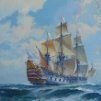-
Posts
1,145 -
Joined
-
Last visited
Reputation Activity
-
 Keith_W got a reaction from msberkman in HMS Royal William by KeithW - Euromodel - 1/72
Keith_W got a reaction from msberkman in HMS Royal William by KeithW - Euromodel - 1/72
I have been giving a great deal of thought as to how to proceed with this build. I have now completed the first planking up to the main deck level. To my immense relief, the planks are still straight, which means that each deck installed so far is exactly parallel with respect to the others.
Other builders of the RW on MSW have decided to continue the first planking upwards, but I am nervous about doing this. Any planking above the main deck is unsupported by frames, and thus potentially vulnerable if the ship is turned upside down.
I have therefore decided to start my second planking at the waterline and work downwards and upwards. These photos show that the waterline has been drawn with a thick black marker.
If you look closely, you will note that I am using pear strips which I bought from Jeff at Hobbymill for the planks above the waterline, and the Euromodel supplied strips below the waterline. The reason is to save cost by saving the expensive pear strips for planking which will actually be visible. The planks below the waterline will be hidden by white paint.
(EDIT) I forgot to mention - the 2013 edition of "SHIPWRIGHT" magazine has a feature by Mr. Yankovitch who scratchbuilt the 1:36 scale Royal William. It is well worth reading, he talks about his technique and how he overcame various problems. I bought my copy on Kindle. Amazon link is here:
http://www.amazon.com/Shipwright-2013-International-Maritime-Modelmaking-ebook/dp/B00GZ8EPPM/ref=sr_1_1?s=books&ie=UTF8&qid=1416144214&sr=1-1&keywords=shipwright+2013
-
 Keith_W got a reaction from maggsl_01 in HMS Royal William by KeithW - Euromodel - 1/72
Keith_W got a reaction from maggsl_01 in HMS Royal William by KeithW - Euromodel - 1/72
I have been giving a great deal of thought as to how to proceed with this build. I have now completed the first planking up to the main deck level. To my immense relief, the planks are still straight, which means that each deck installed so far is exactly parallel with respect to the others.
Other builders of the RW on MSW have decided to continue the first planking upwards, but I am nervous about doing this. Any planking above the main deck is unsupported by frames, and thus potentially vulnerable if the ship is turned upside down.
I have therefore decided to start my second planking at the waterline and work downwards and upwards. These photos show that the waterline has been drawn with a thick black marker.
If you look closely, you will note that I am using pear strips which I bought from Jeff at Hobbymill for the planks above the waterline, and the Euromodel supplied strips below the waterline. The reason is to save cost by saving the expensive pear strips for planking which will actually be visible. The planks below the waterline will be hidden by white paint.
(EDIT) I forgot to mention - the 2013 edition of "SHIPWRIGHT" magazine has a feature by Mr. Yankovitch who scratchbuilt the 1:36 scale Royal William. It is well worth reading, he talks about his technique and how he overcame various problems. I bought my copy on Kindle. Amazon link is here:
http://www.amazon.com/Shipwright-2013-International-Maritime-Modelmaking-ebook/dp/B00GZ8EPPM/ref=sr_1_1?s=books&ie=UTF8&qid=1416144214&sr=1-1&keywords=shipwright+2013
-
 Keith_W got a reaction from marktiedens in HMS Royal William by KeithW - Euromodel - 1/72
Keith_W got a reaction from marktiedens in HMS Royal William by KeithW - Euromodel - 1/72
I have been giving a great deal of thought as to how to proceed with this build. I have now completed the first planking up to the main deck level. To my immense relief, the planks are still straight, which means that each deck installed so far is exactly parallel with respect to the others.
Other builders of the RW on MSW have decided to continue the first planking upwards, but I am nervous about doing this. Any planking above the main deck is unsupported by frames, and thus potentially vulnerable if the ship is turned upside down.
I have therefore decided to start my second planking at the waterline and work downwards and upwards. These photos show that the waterline has been drawn with a thick black marker.
If you look closely, you will note that I am using pear strips which I bought from Jeff at Hobbymill for the planks above the waterline, and the Euromodel supplied strips below the waterline. The reason is to save cost by saving the expensive pear strips for planking which will actually be visible. The planks below the waterline will be hidden by white paint.
(EDIT) I forgot to mention - the 2013 edition of "SHIPWRIGHT" magazine has a feature by Mr. Yankovitch who scratchbuilt the 1:36 scale Royal William. It is well worth reading, he talks about his technique and how he overcame various problems. I bought my copy on Kindle. Amazon link is here:
http://www.amazon.com/Shipwright-2013-International-Maritime-Modelmaking-ebook/dp/B00GZ8EPPM/ref=sr_1_1?s=books&ie=UTF8&qid=1416144214&sr=1-1&keywords=shipwright+2013
-
 Keith_W got a reaction from Bill Morrison in HMS Royal William by KeithW - Euromodel - 1/72
Keith_W got a reaction from Bill Morrison in HMS Royal William by KeithW - Euromodel - 1/72
INDEX OF PLANS
Sheet 1: Overview of ship
Sheet 2: Masts and Yards
Sheet 3: Decorations
Sheets 4, 5, 6, 7: General construction details
Sheet 8: Longitudinal and Cross section (for scratch builders)
Sheets 9, 10: Deck furniture
Sheets 11, 12: Standing rigging
Sheets 13, 14, 15: Running rigging
Sheet 16: Mast and yard details
Sheet 17: Ships plan
-
 Keith_W got a reaction from CaptainSteve in Let's talk 3D printers.
Keith_W got a reaction from CaptainSteve in Let's talk 3D printers.
I have been doing some research on 3D printers. I am planning to make some rail stanchions. Question is - do I feel like turning 100 of these on my lathe, or would it be easier to draw up a design on CAD and either buy a printer or get someone to print it for me?
I have looked around the market to see where 3D printers are at at the moment. There seem to be two main types which could be considered for home enthusiast. This is a quick run-down of the pros and cons I have learnt so far:
- SLA (Stereolithography). A plate is immersed in liquid resin, then spots on the resin are hardened by focusing a laser on it. When one layer is done, the plate is re-coated in resin and the process is repeated. When the print is done, the piece is removed from the plate (supposedly it needs to be chiselled off), washed in alcohol to remove excess resin, and supports trimmed off. Pros: extremely high resolution, in the order of 20-30 microns. Very fast. Very quiet. Cons: the printers are expensive (the cheapest seems to be the FormLabs, at $3800), the resin is expensive, and it is really messy. Also, larger sized printers are very expensive, but that won't matter to us because we are mostly after small size and precision.
- FFF (Fused Filament Fabrication) / FDM (Fused Deposition Modelling). By far the more common type. A plastic filament is fed into a heated nozzle, which moves around and deposits layers of plastic, building up the piece layer by layer. Pros: more affordable, machines as cheap as $1k. Filaments are cheap and available in many colours and textures. Cons: relatively low resolution, the best I have seen are 100 micron. Also, most inexpensive FFF printers require assembly, or are very small companies that received Kickstarter funding (I am quite wary of those), and I have read quite a few reports of unreliable printers that - if they are not producing misshapen prints, they suffer from hardware failure.
There are a few other types of printer on the market but I have not listed them.
Also note it is NOT my intention to sound like an expert, I am merely listing things I have learnt so far to put up for discussion!
I would like to know if any members have ventured into 3D printing. It may be quite useful for making many copies of parts that we find annoying to fabricate. Going over my current build, I would use a 3D printer to make:
- stanchions
- window frames
- boats
- gun carriages and guns
- ship's stove
The number of potential applications seems fairly long, which is why I am thinking of buying a 3D printer for myself. Question - do people think that 3D printers are a mature enough technology for the non-enthusiast or professional market? Is 100 Micron resolution "good enough"?
-
 Keith_W got a reaction from Landlubber Mike in HMS Royal William by KeithW - Euromodel - 1/72
Keith_W got a reaction from Landlubber Mike in HMS Royal William by KeithW - Euromodel - 1/72
I have been giving a great deal of thought as to how to proceed with this build. I have now completed the first planking up to the main deck level. To my immense relief, the planks are still straight, which means that each deck installed so far is exactly parallel with respect to the others.
Other builders of the RW on MSW have decided to continue the first planking upwards, but I am nervous about doing this. Any planking above the main deck is unsupported by frames, and thus potentially vulnerable if the ship is turned upside down.
I have therefore decided to start my second planking at the waterline and work downwards and upwards. These photos show that the waterline has been drawn with a thick black marker.
If you look closely, you will note that I am using pear strips which I bought from Jeff at Hobbymill for the planks above the waterline, and the Euromodel supplied strips below the waterline. The reason is to save cost by saving the expensive pear strips for planking which will actually be visible. The planks below the waterline will be hidden by white paint.
(EDIT) I forgot to mention - the 2013 edition of "SHIPWRIGHT" magazine has a feature by Mr. Yankovitch who scratchbuilt the 1:36 scale Royal William. It is well worth reading, he talks about his technique and how he overcame various problems. I bought my copy on Kindle. Amazon link is here:
http://www.amazon.com/Shipwright-2013-International-Maritime-Modelmaking-ebook/dp/B00GZ8EPPM/ref=sr_1_1?s=books&ie=UTF8&qid=1416144214&sr=1-1&keywords=shipwright+2013
-
 Keith_W got a reaction from mtaylor in Let's talk 3D printers.
Keith_W got a reaction from mtaylor in Let's talk 3D printers.
I have been doing some research on 3D printers. I am planning to make some rail stanchions. Question is - do I feel like turning 100 of these on my lathe, or would it be easier to draw up a design on CAD and either buy a printer or get someone to print it for me?
I have looked around the market to see where 3D printers are at at the moment. There seem to be two main types which could be considered for home enthusiast. This is a quick run-down of the pros and cons I have learnt so far:
- SLA (Stereolithography). A plate is immersed in liquid resin, then spots on the resin are hardened by focusing a laser on it. When one layer is done, the plate is re-coated in resin and the process is repeated. When the print is done, the piece is removed from the plate (supposedly it needs to be chiselled off), washed in alcohol to remove excess resin, and supports trimmed off. Pros: extremely high resolution, in the order of 20-30 microns. Very fast. Very quiet. Cons: the printers are expensive (the cheapest seems to be the FormLabs, at $3800), the resin is expensive, and it is really messy. Also, larger sized printers are very expensive, but that won't matter to us because we are mostly after small size and precision.
- FFF (Fused Filament Fabrication) / FDM (Fused Deposition Modelling). By far the more common type. A plastic filament is fed into a heated nozzle, which moves around and deposits layers of plastic, building up the piece layer by layer. Pros: more affordable, machines as cheap as $1k. Filaments are cheap and available in many colours and textures. Cons: relatively low resolution, the best I have seen are 100 micron. Also, most inexpensive FFF printers require assembly, or are very small companies that received Kickstarter funding (I am quite wary of those), and I have read quite a few reports of unreliable printers that - if they are not producing misshapen prints, they suffer from hardware failure.
There are a few other types of printer on the market but I have not listed them.
Also note it is NOT my intention to sound like an expert, I am merely listing things I have learnt so far to put up for discussion!
I would like to know if any members have ventured into 3D printing. It may be quite useful for making many copies of parts that we find annoying to fabricate. Going over my current build, I would use a 3D printer to make:
- stanchions
- window frames
- boats
- gun carriages and guns
- ship's stove
The number of potential applications seems fairly long, which is why I am thinking of buying a 3D printer for myself. Question - do people think that 3D printers are a mature enough technology for the non-enthusiast or professional market? Is 100 Micron resolution "good enough"?
-
 Keith_W reacted to Shipyard sid in Royal Caroline 1749 by Shipyard sid - Panart - 1/47 scale
Keith_W reacted to Shipyard sid in Royal Caroline 1749 by Shipyard sid - Panart - 1/47 scale
Greetings all
Well here I go with my second build, which was not my chosen build. My chosen ship was the Pegasus by Victory models after following blue ensigns cracking build. I received the pegasus for my birthday in July and was ready to start the build on the completion of my first build. The Admiral was chatting to a friend who came to visit and was telling her about my late father who built lots of model ships, and saying how clever he was. She said to her friend the last two ships he built were galleons and and he built them side by side. She turned to me and said I don't want you to build that ship you have now, I want you to build a galleon. So after looking at the kits on CMB and photos she along with her friend decided the Royal Caroline was nice. It was not worth arguing so I am now building the Royal Galleon Caroline. I made a start a few weeks ago and have just started the first planking, and things are going ok. And at the minute this will be a straight foward build, but we will see what's what when the planking is completed. There are some really cracking builds going on here with all you enthusiastics, so I should not be lost for advice or help if needed. Well here we go we are off and running. Here's a few photos of my Galleon. DAVID
-
 Keith_W reacted to CaptainSteve in The Kit-Basher's Guide To The Galaxy
Keith_W reacted to CaptainSteve in The Kit-Basher's Guide To The Galaxy
FILE FASTENERS (and BAND-AIDS) – To make 1/16 scale cutlasses as detail for my Bounty Launch, I used some file fasteners, plus a few other common items.
You will need: File Fastener; Piece of brass strip; Piece of tubing (plastic/metal); A small, metal bead; Strip of aluminium foil; A band-aid (cloth variety).
Flatten the file fastener. I put mine between two metal rulers and then hammered along the length. With the ones I used, there was a brand indentation which could not be completely hammered out.
(At a casual glance, it almost looks like a Royal Crest !!).
Cut out the rough shape of your sword. Bear in mind to leave enough for the “Tang”. This is the part extending back from the blade which will later form the interior of the handle.
The Dremel tool makes the shaping process a little easier …
Cut a short piece of tubing to become the Grip. This fits over the Tang. It needs to be approx. 3mm shorter, allowing the tip of the Tang to stick out …
This part is entirely optional, but I chose to dry brush my blades with, first, a metallic chrome, and then a matt gloss.
Cut short pieces of the brass strip to make the Hand Guard. This piece will need to be approx. twice the length of the Tang. Drill a hole at each end (approx 0.5cm in), and then round them off, using the Dremel.
(A tip: clip the corners with nail-trimmers first.)
Next up, bend the brass strips over a suitable tool (I used my hand-drill) to form the Guard.
Here are all the pieces set out and almost ready to begin …
But first, make some strips of aluminium foil. Fold them over onto themselves a few times, to give them extra strength. These strips will become the Rain Guards on your swords (but, more importantly, they will serve to make the join between hilt and blade look much tidier).
WARNING: It can be a bit fiddly putting everything together. Test-fitting of pieces before applying glue is highly recommended to ensure that nothing breaks and needs to be re-made.
Apply small amount of Epoxy glue to the Tang and top part of blade. Thread Tang through hole in one end of the Guard. Slide the Grip into place. Make sure the Tang protrudes from the other end, and then poke it through the top hole of the Guard.
I used a pair of pliers to grip the two ends of the Guard together whilst the glue dries. You will want to apply just enough force to keep the Guard flush against the ends of the Grip piece.
Quickly, before the glue can dry, place the small bead onto the end of the Tang, now protruding through the top of the Guard. This becomes the Pommel (or Peen Block), holding everything together.
It should look something like this …
Wrap an aluminium strip around your blade (two turns is enough), sliding it up against the bottom of the Guard to ensure it is flush ...
Once the epoxy has set, take the cloth band-aid. Cut a short strip to the length of the Grip. Carefully wrap this around the tubing piece.
(NOTE: Originally, I was going to wrap cotton around the Grip. But, I have been desperately trying to find an excuse to feature Band-Aids in Kit-Basher’s.)
And here they are, together with the drawing which inspired them …
EDIT: The rain guards are most probably NOT historically accurate for basic cutlasses.
-
 Keith_W reacted to NMBROOK in MORDAUNT 1681 by NMBROOK - Euromodel - 1:60 - Beyond Bashed
Keith_W reacted to NMBROOK in MORDAUNT 1681 by NMBROOK - Euromodel - 1:60 - Beyond Bashed
After spending a few hours scouring the net,I have eventually found a supplier of super small drills.I have purchesed two 0.18mm drills for adding the grating nailing.These drills have double stepped down shanks enabling them to fit in the 3.2mm Proxxon collet.I am certain a chuck would have far too much 'run out' to drill these holes.I intend to use them solely in the miller.They are very expensive at around ten pounds each,but are carbide and hopefully will last for a large number of holes.I have ordered a reel of 0.15mm copper wire for the nails.For scale purists,this equates to 9mm full size,so isn't miles away.
If anyone is in the market for some mega small drills(yes they do smaller ones than these )the website is
http://www.drill-service.co.uk/index.asp
Kind Regards
Nigel
-
 Keith_W reacted to CaptainSteve in Bounty Launch by CaptainSteve - FINISHED - Model Shipways - 1:16 Scale - SMALL
Keith_W reacted to CaptainSteve in Bounty Launch by CaptainSteve - FINISHED - Model Shipways - 1:16 Scale - SMALL
This past week, Our Hero hath continued to work on the various detail items to be included.
And here, he hath madeth a list:
Indeed, just this very day he didst PhotoShop a tick unto the top o' the list upon his return from the faraway land of Nippon where he didst journey to learn the ancient secrets of sword forging.
“I shalt not repeateth myself here,” CaptainSteve was heard to mutter. “For I hath detailed in the Kit-Basher’s forum me method fer making these."
So, please, clicketh here to check it out.
Now, as we know, Mr Bligh was not the most personable of people. Indeed, ‘tis known that even amongst the loyalists in the Launch with him, only a handful of men could be relied upon. Thusly, Our Hero hast reasoned that Bligh would’ve been certain to keep all the weapons onboard within easy reach.
“Hence I shalt most probably be placing the four cutlasses (and two native spears) that hath been documented up Bligh’s end of the Launch,” CaptainSteve didst explain.
Re-visiting the tool-chest, for now, three of the cutlasses have been lazily placed inside.
“Thee final one couldst well be chopped into the edge of one of the rear benches,” our Hero didst suggest. “Mayhaps next to where ol’ Bligh hisself be sitting.”
-
 Keith_W reacted to RMC in HMS Vanguard by RMC - FINISHED - Amati/Victory Models - scale 1:72
Keith_W reacted to RMC in HMS Vanguard by RMC - FINISHED - Amati/Victory Models - scale 1:72
Here is the beginning of the main yard. There was not as much progess over the weekend as I'd hoped. Doing the octagonal centre piece turned out to be not as difficult as I first thought and it turned out quite well. Having more suitable tools would have helped however in making the edges more defined. Once I had worked out the dimensions of each side of the octogon, I used Tamiya tape to delineate the edges, then used an Exacto knife to plane the surface flat. (The little plane I bought has proven to be the most useless tool in the box.)
Once the octagonal section was done I used my Proxxon lathe to taper each end. The tapering was done in stages. For example I first measured 40 mm along the yard from the end of the octagonal section, referred to the plan to see the thickness of the yard at that point, and tapered the intervening distance appropriately. I then did to same for the next 40 mm ...... The following picture shows about 80mm tapered.
Here is the (semi) finished yard tapered at both ends (the tapers turned out to be pretty well spot on to my pleasant surprise). The octagonal section does not show up well in the photo unfortunately
-
 Keith_W got a reaction from jburchfield1@wowway.com in Bounty Launch by jburchfield1 - Model Shipways - 1:16 - SMALL - 2nd build
Keith_W got a reaction from jburchfield1@wowway.com in Bounty Launch by jburchfield1 - Model Shipways - 1:16 - SMALL - 2nd build
Hi Pops, I think the various build logs (including mine) will give you good pointers for things to watch out for. I'll be following your build. Curious to see what you do with this
BTW, if you plan to vary your rigging from the plans, you will need to get yourself more rope.
-
 Keith_W got a reaction from DenPink in Royal William by Denis R - Euromodel - Scale 1:72
Keith_W got a reaction from DenPink in Royal William by Denis R - Euromodel - Scale 1:72
I see that your kit has the same problem as mine. Bulkheads "C" and "D" do not reach all the way down to the level of the false keel. I had to shim these prior to bevelling. I can also see the the top of bulkhead "F" does not sit level with bulkheads B-E. Same with mine
-
 Keith_W reacted to DenPink in Royal William by Denis R - Euromodel - Scale 1:72
Keith_W reacted to DenPink in Royal William by Denis R - Euromodel - Scale 1:72
Hi
Well I have dived into the RW box.
I have dry fitted the frames, some are a bit loose and will need packing out ( about 0.50 x 5mm ).
Denis.
-
 Keith_W reacted to Johncclark in Euromodel Como Kit Discussion
Keith_W reacted to Johncclark in Euromodel Como Kit Discussion
Surprise had a rounded forecastle and chase ports. Modified the kit.
-
 Keith_W reacted to Johncclark in Euromodel Como Kit Discussion
Keith_W reacted to Johncclark in Euromodel Como Kit Discussion
Here is a bow on view of Surprise aka Ajax. Figure head is a work in progress. Copper hull plates are Caldercraft , about 850 of them. Not a hard job, took about a week.
-
 Keith_W reacted to Cap'n Rat Fink in Bounty Launch by KeithW - FINISHED - Model Shipways - SMALL - kitbashed
Keith_W reacted to Cap'n Rat Fink in Bounty Launch by KeithW - FINISHED - Model Shipways - SMALL - kitbashed
VERY WELL DONE KEITH.
MARIO
-
 Keith_W got a reaction from Cap'n Rat Fink in Bounty Launch by KeithW - FINISHED - Model Shipways - SMALL - kitbashed
Keith_W got a reaction from Cap'n Rat Fink in Bounty Launch by KeithW - FINISHED - Model Shipways - SMALL - kitbashed
Today was a happy day modelling. That is, until I received a phone call from my best friend's mother. He passed away from a motorbike accident - apparently he crested a hill and encountered a vehicle driven by a drunk driver travelling on the wrong side of the road: http://www.watoday.com.au/wa-news/claremont-man-killed-in-albany-crash-20140322-359rc.html
I am completely numb at the moment. After I put down the phone I continued to work but my mind was a blank.
Anyway, i'll just leave these here:
I think i'll continue doing work. It was strangely therapeutic.
-
 Keith_W got a reaction from Shepherd in Bounty Launch by KeithW - FINISHED - Model Shipways - SMALL - kitbashed
Keith_W got a reaction from Shepherd in Bounty Launch by KeithW - FINISHED - Model Shipways - SMALL - kitbashed
Thanks for all the comments and likes, everyone!
Anyway, I did some work on the carpenter's chest. I modelled it in the open position. I took inspiration from Cap'n Rat Fink's chest here: http://modelshipworld.com/index.php?/topic/849-hms-bounty-launch-by-teleman-116-bashed-completed/?p=12090 (copied the hollow lid idea), as well as Meredith's hinges here: http://modelshipworld.com/index.php?/topic/2160-hms-bounty-launch-by-meredith-modelshipways/?p=143922
At the time I was wondering whether I could make metalwork as fine as hers, but as it turns out ... I can't. Try as I might, I am not able to make two "F" shapes in the supplied brass strip, so I made an "I" and a "C" instead. Still, I think the result looks OK.
Here are some pictures for your viewing pleasure or amusement. Probably the latter
-
 Keith_W got a reaction from Cap'n Rat Fink in Bounty Launch by KeithW - FINISHED - Model Shipways - SMALL - kitbashed
Keith_W got a reaction from Cap'n Rat Fink in Bounty Launch by KeithW - FINISHED - Model Shipways - SMALL - kitbashed
Oh well, looks like nobody could answer my question Anyway, I took a look at the Occre kit, and I noticed that they had deadeyes in the shrouds. So deadeyes it is.
Unfortunately, my soldering skills leave much to be desired. The iron doesn't get hot enough, and when the solder melts, it forms a little ball and refuses to go into the metal. I then read Russell Barnes' silver soldering tutorial then remembered I had some silver solder coil (not paste!) in my toolbox. After quite a lot of rummaging, I found it.
I then spent a few hours experimenting with different methods to make these damned things without burning the deadeyes. I came up with this:
I wrapped the deadeye in some tissue paper, then saturated it with water. The water cools down the wire around the deadeye, preventing it from burning. It worked a treat.
I have decided to make a bowsprit. McKay's plans include a bowsprit holder (whatever you call it). I fabricated one by forming a ring with brass plate, soldering it shut, then soldering a brass rod onto it.
After much shaping, this is what it looks like. I have yet to finish fine sanding and blackening - that will come later.
This is what it looks like attached to the bowsprit.
Unfortunately, my metal blackener leaves much to be desired. As the picture shows, it is the "Krick" brand. This picture shows some brass pieces which have been cleaned in methylated spirits, then detergent, then left in the blackener for one hour! As you can see it is nowhere near black. Only the copper has oxidized a little. Silver solder does not change colour at all, and "ordinary" solder turns grey, not black. About the only thing that turns black is wood!
Real waste of money. I wonder if anyone else uses Krick and whether they have had good results?
-
 Keith_W got a reaction from Cap'n Rat Fink in Bounty Launch by KeithW - FINISHED - Model Shipways - SMALL - kitbashed
Keith_W got a reaction from Cap'n Rat Fink in Bounty Launch by KeithW - FINISHED - Model Shipways - SMALL - kitbashed
Thanks for the comments guys. Esion, if you could post a build log of your boat that would be helpful.
The hull is now completed, and I am about to start installing the floorboards, etc. I have been poring over the other Bounty Launch build logs on MSW with a microscope, and I note that Mario (Cap'n Rat Fink) repositioned the masts on his boat (see here). Did he make the right decision?
Photo 1: Model Shipways. This is an image from the Bounty instructions (the plans are too big to fit in my scanner). I have numbered the frames 1-15 as per the convention in the manual, but if you count the tween frames there should be 26. However, as noted in an earlier post I added two frames, so I have 28. Note the position of the mainmast relative to the windlass holder.
Photo 2: National Maritime Museum. This is an image of the plans of the Bounty Launch from the National Maritime Museum. The positions of the foremast and mainmast are not indicated on these plans.
Photo 3: AOTS: Bounty. These are the plans from Mackay's AOTS: Bounty. I have numbered the frames for convenience.
Comparing the three plans, a number of observations can be made:
1. The number of frames in each set of plans is radically different. MS has 26, NMM has 16, and AOTS:Bounty has 18. Also, the frames on the bow are canted on the MS kit, whereas they are straight on NMM and AOTS:Bounty.
2. The position of the windlass (expressed as a ratio to the length of the ship - larger number means the windlass is closer to the bow) is 0.55:1 on the MS kit, 0.56:1 on the NMM plans, and 0.55:1 on Mackay - all three sources agree.
3. The position on the mainmast, again using the same convention, is 0.38:1 on the MS kit, and 0.49:1 on Mackay. You can see the difference just eyeballing the photos.
4. Mackay depicts a bowsprit - this is not included in the MS kit. I have to decide whether or not to create one. Mario decided that the Launch is too small to include a bowsprit, but I will probably go with Mackay's plans.
5. The MS kit does not include a crane, or a windlass (but they do include plans, but not material for fabricating one if you wish). The booklet says that the crane and windlass were probably left on the Bounty when Bligh was set adrift - so these items were not included. Do I make my own? Decisions, decisions ...
6. Mackay depicts six thwarts and six oars per side. The oarlocks on Mackay are simply cutouts on the sheer plank. The NMM plans do not depict any oars or oarlocks, but does depict six thwarts. However - MS includes five thwarts and five pairs of oars. The oarlocks on Mackay are dowels insert in the gunwale. Interesting decision by MS - it is not too late in my build to severely kitbash and try to get my Launch to look more like Mackay's, but the very thought of fabricating a new gunwale takes the wind out of my sails. I will probably stick with MS - the gunwale they included looks nice.
I now have to decide whether to paint the inside of the Launch or not. My original idea was to stain the planks and floorboards, thwarts, etc. different coloured stains to make them stand out, but I am not sure if I should introduce another colour (perhaps red). Nobody knows how the interior of the Launch was painted, so I suppose that gives me considerable artistic license! It will probably end up as an aesthetic decision, more than anything else!
Now after all that, did Mario make the correct decision? Take a look at his boat:
Now take a look at what it would look like if built to the instructions provided by MS:
I think there is no question that the mast should be closer to the windlass. It even looks more correct. Unfortunately, repositioning the mainmast means that all sorts of things have to be fabricated or shifted - new thwarts have to be made, holes filled and moved, etc. My homework for tonight is to study the plans and see if I have enough material to do it.
-
 Keith_W got a reaction from maddog33 in Bounty Launch by KeithW - FINISHED - Model Shipways - SMALL - kitbashed
Keith_W got a reaction from maddog33 in Bounty Launch by KeithW - FINISHED - Model Shipways - SMALL - kitbashed
Thanks Jeff-E
Anyway, I managed to do more work yesterday and today.
After installing the cant frames, I noted that there is a gap between frames 2-3, and 3-4 as per the plans. I then checked with McKay's AOTS Bounty and saw that the boat as depicted by MS differed from McKay. I am not sure which is more correct, but it sure looks strange - especially since the frames are visible on my build.
... I therefore bent a couple more ribs and taped them in place. They look MUCH better in my opinion. I therefore glued them in place.
After the hull was sanded down, I drilled dozens of little holes and started plugging them with treenails. I thought I would hate putting treenails in, but it's actually quite fun. Unfortunately, I ran out of walnut dowel to make treenails, so I had to substitute. This meant studying the plans to see which treenails were going to be visible. Anything below the waterline was not critical - I planned to paint it. That left the internal treenails. I made some more treenails with bamboo, and thought I would simulate treenails with woodfiller.
I was concerned that the treenails would look different, so I only used bamboo and woodfiller treenails on areas that would be painted over. Here is the hull after drying, about to start sanding.
Sanding is complete, and I stained the wood again. Once stained, it is quite difficult to tell the difference between bamboo and walnut, but I can tell you that it is MUCH easier to draw walnut through a drawplate than bamboo! It is just a more pleasant wood to work with.
This photo shows the difference between the walnut treenails and the simulated treenails using woodfiller. It doesn't really do justice - the real treenails look MUCH better in real life - it just looks more defined and sharper.
-
 Keith_W got a reaction from Cap'n Rat Fink in Bounty Launch by KeithW - FINISHED - Model Shipways - SMALL - kitbashed
Keith_W got a reaction from Cap'n Rat Fink in Bounty Launch by KeithW - FINISHED - Model Shipways - SMALL - kitbashed
Thanks Cap'n Bob, Dan, Tom, Jeff, and Scott. I have had the whole week off for Christmas, Boxing day, and New Years - no prizes for guessing what I have been doing
I pre-stained the planks prior to installation. As you can see from the photo, the wood is porous enough to let the stain seep through from the other side. I deliberately stained some planks more aggressively than others to give some variation in colour between the planks when it is assembled. I am very happy with the colour of the stain - it is exactly what I wanted.
After 24 hours to allow the stain to dry, I soaked the planks and steam bent them, again using the frame as a jig. It took me a whole day to bend all the planks, and then I waited 24 hours for the planks to dry. In previous models I have attempted to install planks which have not been thoroughly dried. Bad mistake to make - wet planks expand. When they dry, they contract - leaving unsightly gaps in the planking. Given this is a single planked boat, I did not want this to happen.
Planking begins! The picture shows the garboard plank fitting snugly in the rabbet.
Since I am planning to treenail this boat, I thought I would make a treenail marking jig. I used some spare grating material from another kit. The pictures are self explanatory.
Planking continues. I was have read the other Bounty Launch build logs thoroughly and was very careful to follow the planking marks. The instructions suggest you can either alternate between planking from the garboard up and sheer down, or plank from the sheer down. I decided to alternate - so: 1, 10, 2, 9, 3, 8 ... etc.
I note that usedtosail had a problem with his shutter plank (see here). Well, I encountered the same problem. It appears as if the shutter plank is not the same size as depicted on the plans. Unlike Tom, I do not have any spare basswood in order to cut myself a new plank.
I will have to install a stealer. I am quite annoyed that I have to install a stealer on a kit which features laser cut strakes, but then none of the other modellers reported a problem - so perhaps it is my own fault. I'm not quite sure where I went wrong, but a word of warning for anybody planning to build this launch. Watch out for this - if it appears that you need to trim wood at the stern, DON'T. At least not until you get to test fit the shutter plank.
I am also annoyed that the stealer will be above the waterline. I was planning to paint the kit at the waterline, and stain everything above it. The stealer will unfortunately be quite visible!
In any case, I don't want to deal with it tonight. That will have to be a job for tomorrow. I'm off to bed now.
-
 Keith_W got a reaction from Brian the extraordinaire in HMS Royal William by KeithW - Euromodel - 1/72
Keith_W got a reaction from Brian the extraordinaire in HMS Royal William by KeithW - Euromodel - 1/72
Peter, with no disrespect to Keith Julier, I found your RW resource much more helpful. For a start, your Interpretive Info contains logs from other modellers, and thus more than one interpretation of how the build should go. I am not sure I agree with you in all respects, e.g. my interpretation of the plans slightly differ to yours and Julier's. In time, my model might end up looking like some horrible cobbled together matchstick monstrosity (which would be my punishment for striking out my own way instead of listening to more experienced modellers), and everyone on MSW will be able to see it But then again, it may not!
Wombat, I am glad that my criticism of the kit has not dissuaded you. I would like to say again - I am not bashing Euromodel. Well, apart from my disappointment at some of the castings and parts. But those can be worked around. The subject of the kit is unique, and the model is beautiful. I had one look at Brian's, beheld the size of the thing and its sheer beauty (not to mention Brian's craftsmanship), and I was instantly smitten. You really need to see a well built model and you will be convinced.











